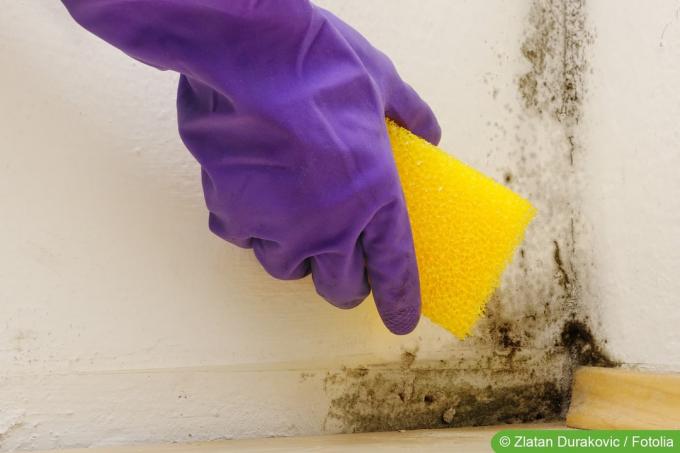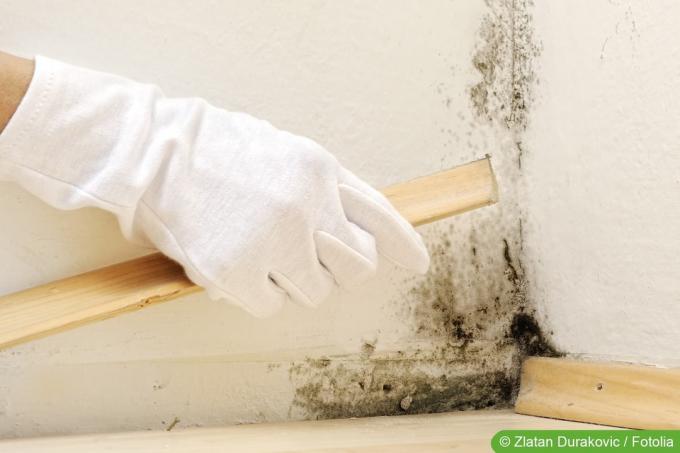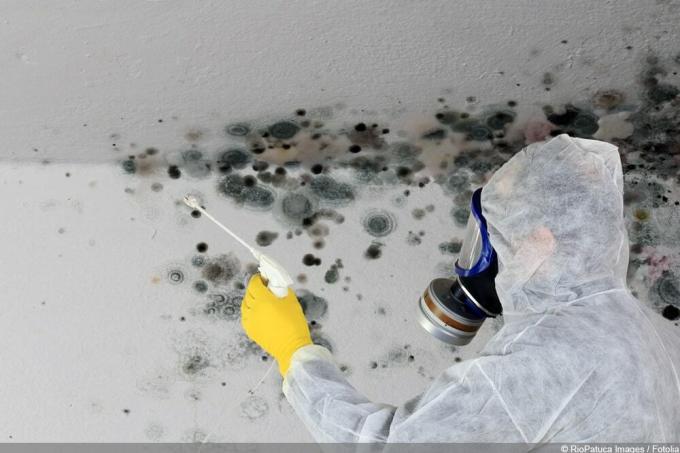

Table of contents
- Benefits of Chlorine
- Disadvantages of chlorine
- Safety measures
- Application
- textiles
- plastic
- Wood
- wallpaper and plaster
- frequently asked Questions
Chlorine can effectively fight mold, but it is not without risk. In practical use, therefore, some safety measures are required in order not to cause any damage to health or to take unnecessary risks. We show what is important when removing mold with chlorine.
Benefits of Chlorine
The use of chlorine against mold makes sense for many reasons. These key benefits include the following:
- simple application
- inexpensive means
- quick and comprehensive effect
- effective against germs
Chlorine kills all components of the mold. As a result, it is often sufficient to apply the agent once. The prerequisite for this, however, is that the cause of the mold has been eliminated.
Disadvantages of chlorine
Chlorine pollutes the airways and can burn the skin. This already applies to simple and approved solutions. For this reason, precautionary measures must be taken in each case when using it.
A particularly high risk is when mixed with other cleaning agents or mold removal products. Chemical reactions triggered in this way can produce chlorine gas. This is acutely toxic. Even small amounts irritate the airways when inhaled and can lead to severe lung damage.
Tip:
Another potential disadvantage of chlorine is the potential for damage to the material. It should therefore only be used on suitable surfaces.
Safety measures
Appropriate safety measures must be taken due to the potential dangers of using chlorine against mold.
- use breathing mask
- ventilate the affected room continuously
- Do not mix chlorine with other agents
- wear gloves
A notice:
If other agents or special mold removers have already been used on the affected area, chlorine should no longer be used. The seemingly harmless combination of chlorine and vinegar also creates chlorine gas.
Application
The application depends on the material and area to be treated. If mold has formed on washable textiles, the procedure here is different than with furniture or a wall. Nevertheless, the application can be carried out easily and quickly in any case.
textiles
Washable textiles with mildew or mold stains can still be saved if they are treated with chlorine. The following procedure is recommended:
- soak in chlorine-water mixture
- wash several times with chlorine as an addition
- connect normal wash cycles
It should be noted that chlorine has a bleaching effect. It is therefore only suitable for white textiles.
plastic
Porous plastic should not be treated with chlorine. With smooth variants, however, this is possible without any problems.
When applied, the cleaning agent should be absorbed straight into rough surfaces and the mold layer should be allowed to deviate. In contrast to spraying, no spores are stirred up and distributed in the environment. It is ideal to dampen the affected area with a wet cloth beforehand and then spray it with chlorine or place a cloth soaked in chlorine on it.

After the exposure time is wiped several times with pure water. If possible, residual chlorine should be rinsed off.
In the case of rough plastic, it may also be necessary to brush mold residue out of the grooves and repeat the process several times if necessary.
Wood
Mold on wood is occasionally found on garden furniture. Significantly more often it starts from moldy walls and can then be found, for example, on the side panels or back walls of cupboards.
As long as the infestation is only superficial, both chlorine and hydrogen peroxide are suitable for removal. The funds may only be used individually, but both have bleaching effects. This will lighten the dark mold stains.
In the first step, the wood is again moistened with a cloth to prevent spores from being stirred up. Chlorine can then be sprayed on or the area soaked with it and then wiped with pure water.
wallpaper and plaster
A lack of heating, incorrect ventilation, leaking pipes or insulation - mold on the walls, in room corners or on the ceiling is unfortunately not uncommon and often goes unnoticed for a long time. This is especially true when it is behind cupboards or on window frames. Infestations often progress very far before treatment is given. The fight must be correspondingly comprehensive.
In addition, this only makes sense if the cause is known and has been remedied. In the case of a leaking shower, water pipe or a damaged facade with moisture penetrating from the outside, chlorine will only bring about a temporary improvement. However, the mold then spreads again and again.

A small infestation on the wallpaper or plaster is first wiped off with a damp cloth and then sprayed with chlorine. Visible mold residues are dabbed off.
In the case of strong spreads, it is necessary to remove the wallpaper and, if necessary, the plaster. Only then can a treatment with chlorine be carried out to kill any spores that may be present. After complete drying, the renovation can be carried out.
frequently asked Questions
Hydrogen peroxide and vinegar solutions can limit the spread and eliminate mold. An ozone generator can also be used to kill spores that are already in the environment. In any case, it is important to eliminate the cause of the mold so that it does not infest again.
There are now numerous products on the market to combat and remove mold. Whether a single agent is sufficient or whether several applications are required depends, among other things, on the severity of the infestation. If mold spreads or grows again, it is important to eliminate the cause and carry out comprehensive treatment.
In the case of severe infestations, it may be necessary to remove wallpaper and plaster, dispose of it properly and kill the spores. The takeover by a company is already advisable here due to the effort involved. The professional removal of mold also makes sense if health problems already exist and special caution must therefore be exercised.
 Home editorial office
Home editorial office
Learn more about mold

Identify 5 types of mold in the apartment with a picture
Mold in the apartment in the apartment can mean a significant health hazard. In order to contain this and to be able to remove the mold in a targeted manner, the type of mold should first be known. We show how it can be determined.

Mold on the ceiling - causes & solutions
When suspicious spots are discovered on the ceiling, the horror is great, because mold can be harmful to health. So it is necessary to remove it. Anti-mold agents promise easy removal of the mold, but the cause must also be eliminated.

Mold removal by professionals | Cost & Tips
If the mold removal is carried out by a professional, not only visible fungi but also their spores are thoroughly removed. In addition, the cause is clarified. Here you can find out what to look out for when making your selection and what costs to expect.

Coconut mold | 9 tips to keep plants in coconut humus
Moldy coconut soil is unusual - but it can still have various causes. However, there are some simple remedies available to eliminate the problem, so that the plant can usually be saved.

Mold in the plaster - How to remove it successfully
Mold in a corner or an entire wall isn't just a blemish. In the event of a mold infestation, the spores are scattered throughout the room and can cause massive health problems. For this reason, a mold infestation must always be removed.

Mold on Seramis clay granules - what to do?
If indoor plants are switched from soil to clay granules, the initial joy is often great. The maintenance effort is lower, the look is decorative and the plants are doing well too. In many cases, however, apparent mold soon appears on the Seramis clay granules. However, prevention and elimination are simple.


